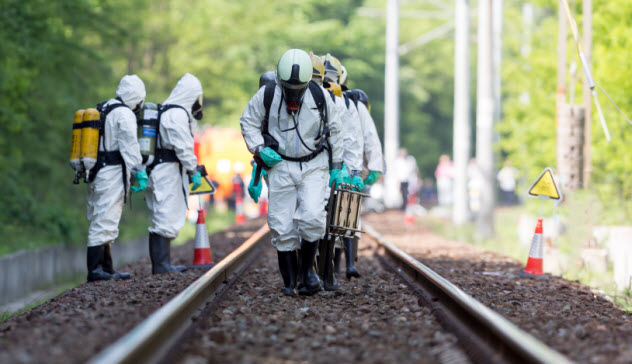See, the future is out to get you. For reasons we can’t even begin to fathom, it wants all of us dead. And conveniently, it’s chosen 10 possible ways to do this. Think you’re safe? The following could kill us all before the decade is out.
10 Antibiotic-Resistant Superbugs
Imagine a world where a single cut to your finger could kill you. A world where breaking a bone or giving birth could be a death sentence. No, this isn’t our pitch for Hemophilia: The Movie. This is the world that we’ll all be living in by 2050. Ever since Alexander Fleming accidentally discovered penicillin, the ability of microbes to kill us has declined drastically. Unfortunately, this has coincided with a steep rise in quack doctors prescribing antibiotics for every malady and farmers shooting their animals full of the stuff. This long-term exposure to all classes of antibiotics has allowed bugs to evolve a resistance to these drugs. The worry is that soon every bug on Earth will follow suit. At that point, we’ll reach Armageddon. In a post-antibiotic world, roughly 10 million people will die horribly each year—around one every three seconds. Most of those deaths will be concentrated in Asia and Africa, but Western countries will feel the pain, too. So we should all be lobbying companies to develop new antibiotics, right? Great idea, but what’s their incentive? It costs billions to make a new drug, and companies will never recoup the costs. If they started selling it, all the bugs would build defenses again. The new drug would have to remain as a “weapon of last resort,” devastating any possible profit margin. So no one invests. Unless we come up with an alternative funding model fast, the microbe victory could be here sooner than we expect.
9 A Deadly Global Pandemic
When Spanish flu hit in 1918, it was one of the worst pandemics the world had ever seen. Between 20 and 50 million died—more than were killed in the whole of World War I. A third of the world’s population got terribly sick. Ever since, we’ve been nervously waiting for the next great pandemic. There have been contenders. SARS, swine flu, and H5N1 (bird flu) all caused understandable scares. Ebola also got people worried, although the Ebola virus was never much of a threat outside West Africa. While none of these resulted in mass deaths, that’s not because of our superior pandemic-avoiding skills. The right virus could still devastate the planet in weeks. Scarily, medical professionals already have some contenders. Perhaps the scariest is Nipah virus. A disease that jumped from pigs to humans in Malaysia in 1999, it now has small, regular outbreaks in Bangladesh. The symptoms are terrifying. Vomiting, fever, and muscle pain quickly give way to coma, which swiftly leads to death. As many as 70 percent of those infected die. Such a rate would make Spanish flu seem like a walk in the park. Rift Valley fever is another candidate. An Ebola-like disease, it infected 90,000 Kenyans in 1997. Unlike Ebola, Rift Valley fever can be transmitted by mosquitoes. One look at how quickly Zika virus is spreading should prove how scary this is. That’s before we even get to viruses like Middle East respiratory syndrome (MERS). Chances are, the next pandemic is already brewing. If we’re unlucky, it might be the Big One.
8 Nuclear War Between NATO And Russia
The fear of a nuclear exchange between NATO members and Russia fell out of favor around the late 1980s. Until, that is, 2016 rolled round. In May 2016, Alexander Richard Shirreff, the former deputy commander of NATO, outlined what he saw as the odds of a major war between the West and Russia. His grim prediction was that the world was on course for a nuclear exchange by 2017. Shirreff’s argument can be boiled down to three basic things: Ukraine, Putin’s paranoia, and NATO expansion. According to the former general, the annexing of Crimea by Russia in 2014 has destroyed the post–Cold War settlement. Following international sanctions, Russia has become increasingly paranoid about what it sees as NATO expansionism. Shirreff’s prediction is that Russia will try to break through NATO encirclement by annexing the rest of eastern Ukraine and then invading the Baltic states. Since Estonia, Latvia, and Lithuania are members of NATO, that would de facto spark World War III. What’s the spark that could set off all this death and destruction? An accident. Russian planes are currently playing chicken with NATO jets in the Baltics on a near-daily basis. Earlier this year, two Russian bombers were intercepted heading for the UK. Neither side wants a war. But if NATO shoots down a Russian plane or a Russian pilot accidentally kills a NATO serviceman, things could spill over extremely quickly. And that means a conflict dragging in four of the world’s nine nuclear powers.
7 Nuclear War With China
The only thing more objectively insane than getting dragged into a nuclear conflict with Russia would be getting dragged into one with China. Terrifyingly, this is a real possibility. Welcome to the South China Sea, where China has spent the past few years claiming territory that smaller countries lay claim to. This wouldn’t be a global problem except that the US is frequently allied with those countries. That means if China decides to enter full empire-building mode, the US is duty bound to step in. As is the case with Russia and the Baltics or Ukraine, no one seriously thinks that either the US or China wants a war. The two countries have military arsenals that would ensure annihilation of huge swaths of the planet if they went toe-to-toe. The problem is, a single slipup at times of heightened tension could accidentally trigger World War III. Just recently, China intercepted US spy planes over the region, and there have many near misses over the last few months. Things have become so dangerous that some analysts are predicting a possible war between the US and China as early as 2018.
6 The Dawn Of AI Superintelligence
It sounds like the ridiculous sci-fi entry in our list. The idea that machines will become vastly more intelligent than humans and wipe us all out. But a lot of clever people are extremely worried about this. Stephen Hawking, for one, thinks that AI could wipe out humanity. Elon Musk agrees with him—to the extent that he’s investing billions in AI to ensure that it will be as friendly as possible when it finally comes round. The trouble is, we simply can’t account for all the variables. Even if we go into AI with the best of intentions, we may wind up creating something beyond our control. The idea is that once a machine reaches human-level intelligence, it should have no problem making itself even more intelligent. As its intelligence grows, it gets easier to become ever more intelligent until the machine reaches superintelligence. At that point, the AI would look to us as we must look to snails or a Kardashian—a being capable of performing mental feats that they can’t even conceive of. Only an AI wouldn’t necessarily evolve human empathy along with its big, old brain. At which point, things would get ugly. We have no way of knowing how a superintelligent machine might interpret its programming. Its brain would be so superior to ours that there’s no point in even trying to understand. The classic example is that an AI originally designed to create paper clips may decide that the best way to fulfill its task is to kill all humans and convert the entire universe into paper clips. But even if it has empathy built in, it might go wrong. If it’s programmed to maximize human happiness, it may decide that we’ll all be happier as brains floating in a tank designed to stimulate our pleasure centers. And we’d have no way of stopping it. This moment could already be closer than we think. In 2016, a Google-designed AI beat the world grandmaster at the game of Go, a game exponentially more strategic than chess. This AI milestone wasn’t meant to be reached until 2025.
5 Weaponized Viruses
Despite its scary name, bioterror is a difficult thing to get right. To date, you can count all the major bioterror attacks on a single hand: the US anthrax scare in 2001, a 1984 salmonella attack in Oregon, and the two times that the creepy Japanese cult Aum gassed civilians with sarin. It can be tempting to think bioterror is way down the list of things that ordinary people should be scared about. Right now, that’s totally true. But the future is another matter. As technology improves, we’re edging closer to the point where weaponizing a deadly virus goes from being a terrorist’s pipe dream to something worryingly practical. As far back as 2012, scientists at Cambridge University were raising the alarm about this. According to Professor Huw Price, the steps to engineer a lethal virus have been dramatically simplified over the last few years. “As technology progresses,” he said, “the number of individuals needed to wipe us all out is declining quite steeply.” Since he made that statement, things have only become easier. The truly scary part is that terrorists might one day benefit from this. Imagine a group with the funding of ISIS and the chemical expertise of Aum working in a world where creating a superbug is something that even a small lab can achieve. Then try and tell us this isn’t terrifying.
4 Resurgent Global Terrorism
To call global terrorism “resurgent” at this point risks sounding willfully blind. ISIS is still causing chaos around the world, Turkey is locked in a deadly war with Kurdish separatists, warlords are tearing apart Africa, and Britain recently announced that it expects an Irish Republican bomb attack on English soil in the near future—the first time since the Real IRA exploded a car bomb in London in 2001. But if you think things are bad now, wait until you see just how bad they could get. If Saudi Arabia gets its way, it will become so bad that no one will ever be able or willing to board a commercial airliner again. At the moment, Saudi Arabia is pursuing regime change in Syria. The kingdom is confident that the best way to do this will be to supply the rebels with hundreds of shoulder-mounted surface-to-air missile launchers. The trouble is, some of those rebels have extremely close ties to non-ISIS terror groups like al-Nusra Front. If the jihadists get hold of these weapons, expect to hear many more stories like that of Malaysia Airlines Flight 17, which was shot down over Ukraine in 2015. Although that was an accident, terrorists would deliberately target civilian airliners, possibly all over the Middle East and Europe. So far, the US has convinced Saudi Arabia that this plan is objectively insane. But with Syria’s war grinding on, it could be only a matter of time before the kingdom decides to go for it, consequences be damned.
3 A Pakistan-India Nuclear War
Pakistan and India aren’t exactly the greatest of friends. The two countries have a history of wars, conflicts, skirmishes, and terrorist attacks stretching all the way back to their creation in 1947. Both countries also have access to nuclear weapons. And both are just itching to use them. Although a nuclear war with Russia or China is a distinct possibility, a Pakistan-India showdown is so likely that analysts have called it “only a matter of time.” Pakistan’s unstable government and dysfunctional military is a particular problem, but so is India’s insistence on building up its “second-strike” capacity. Until recently, both countries were at a stalemate with their nuclear technology. Then India started pouring more resources into ballistic submarines, causing Pakistan to freak out. Both are now locked in an arms race and escalating rhetoric the likes of which the world hasn’t seen since the Cuban Missile Crisis. Worst of all, a major Pakistan-India war has the potential to drag China in as well. China has long-standing bad blood with India and may take Pakistan’s side in a potential conflict. In that case, all bets are off. Three nuclear powers would be duking it out, possibly leading to the whole of the subcontinent going up in flames. You’d better believe that would affect you, too—wherever you are.
2 Deadly Weather
One fact of life over the next few decades is going to be extreme weather. As the planet shifts its habits due to climate change, things are going to get a little freaky. Not to mention deadly. With our world set to warm up by 2.0 degrees Celsius (3.6 °F) in the next century or so, we’re going to have to get used to weather events taking a turn for the murderous. In Britain, for example, scientists are already predicting a future of scorching heat waves. Of course, the temperature of a British “heat wave” would probably leave our readers in Australia scoffing. A few days of 28 degrees Celsius (82 °F) are considered newsworthy on the rainy island. But that doesn’t make British heat waves any less worrisome. Currently, hot weather kills around 2,000 elderly Brits each year. Before long, that number is expected to triple to 6,000. Elsewhere, things will be even worse. In the Western US, wildfires will get bigger, meaner, and more frequent—until we might as well rename California the “wildfire state.” Hurricanes and cyclones will become more intense and powerful, and floods will affect people across the globe. If the 20th century was the century when mankind did its level best to kill itself through wars, the 21st may be the century where Mother Nature finishes the job for us.
1 Alien Contact
Okay, we’re the first to admit that this one doesn’t sound so likely. However, we’re not throwing it in as a gag entry. As with AI, some extremely clever people (including, once again, Stephen Hawking) believe that we could make contact with aliens in the next few decades. If that happens, they also believe that there could only be one outcome: the total destruction of humanity. The classic way to illustrate this is to use the image of Columbus coming to America. Except in this version, we’re the unfortunate natives being tricked into taking smallpox-ridden blankets. This is the sort of thing that Hawking was getting at, but others think it could be even worse. If we accept that intelligent life is possible on other planets, then it stands to reason that galaxy-spanning civilizations should have evolved by now. That we’ve never seen any evidence of them could be a very bad sign. Some think our galaxy is in the hands of a vicious “superpredator” civilization. As soon as another intelligent species calls attention to itself, they swoop in and destroy it. In this solution to the Fermi paradox—the equation that suggests alien life should be visible and asks why it isn’t—the only way to avoid annihilation is to stay very quiet and hope that nobody thinks to look in our backwater part of the galaxy. Sadly, this is the polar opposite of what we’re doing. At the moment, many people are actively trying to contact aliens and we keep flinging probes and signals into deep space. As humanity heads out to colonize Mars this century, it may only be a matter of time before the superpredators notice us. If that happens, it’ll make everything else on this list look like a walk in the park.
























